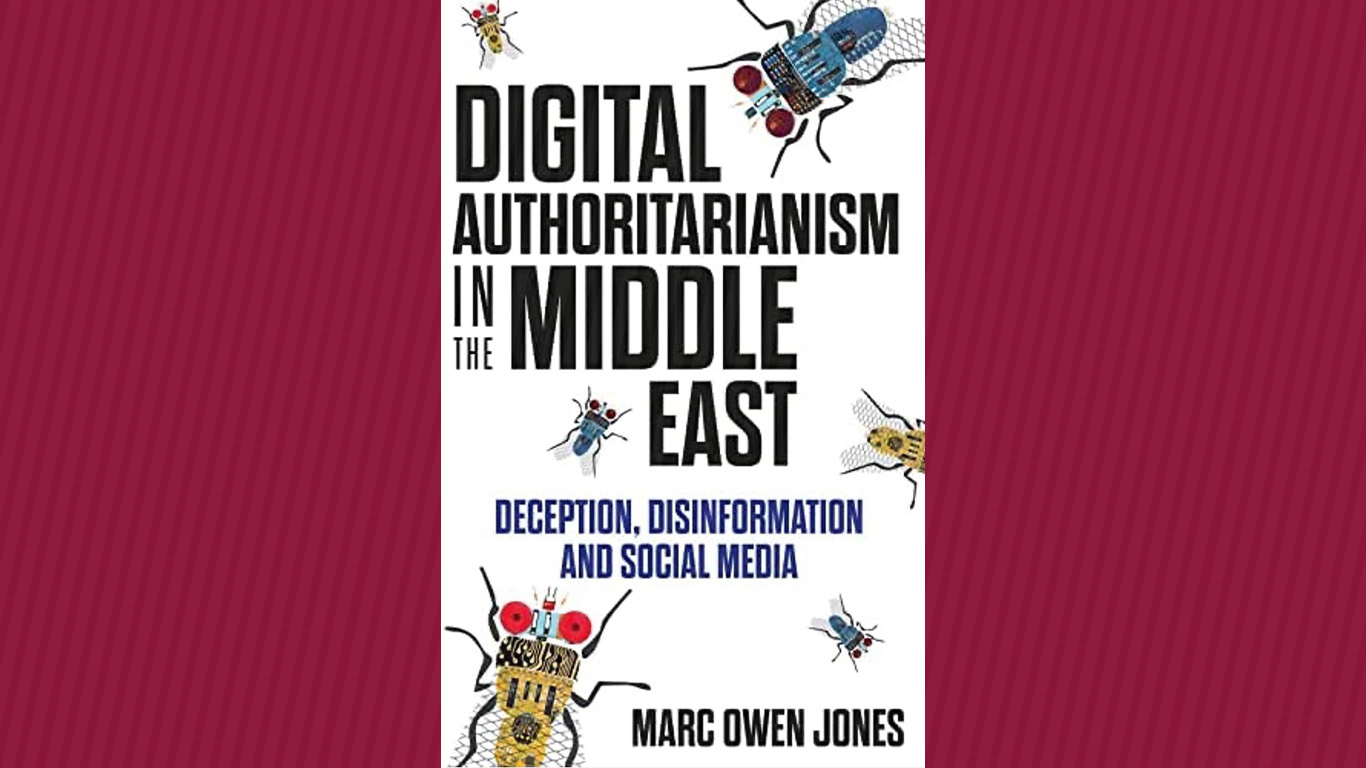Digital Authoritarianism in the Middle East: Deception, Disinformation and Social MediaDigital Authoritarianism in the Middle East: Deception, Disinformation and Social Media
Jones, Marc Owen. 2022
A decade of dedicated work has been poured into Digital Authoritarianism in the Middle East: Deception, Disinformation, and Social Media by Marc Owen Jones. The book comprises of fifteen chapters, including case studies and theoretical discussions that are in-depth and interdisciplinary. In his preface, Jones presents his research analysis on Liliane Khalil, techno-utopianism and weaponized deception in the Middle East and North Africa (MENA).
The preface is one of the most impressive book openings I have read. In a mere three and a half pages, the author demonstrates the potential dangers that social media can pose to ordinary citizens, and not just activists, journalists, or dissidents.
As the author states clearly in the introduction, the book “is not about the positive aspects of our digital information ecosystem; it is about the manipulation of truths and facts designed to serve the agenda of powerful actors that primarily seek to censor and mislead their populations” (p.6). As such, one of the very first characteristics of Digital Authoritarianism in the Middle East is to act as a guideline for the public regarding their social media usage and the consequences of unaccountable technology.
Jones also underlines this nature of the book, stating that he used “public impact scholarship, which is characterized by intentional efforts to create social change through the translation and dissemination of research to nonacademic audiences” (p. 22). The readability of the book is also critical due to the unknown nature of the digital sphere.
Throughout the book, it is noted that research on the digital world requires a unique understanding of software and methodology. In the absence of academic or semi-academic work on the digital world, which includes the concepts of digital authoritarianism, neoliberation technology, and deception, it is difficult for social media users to understand the impact tweets can have on the pseudi-sation of reality.
In particular, the book discusses the KUBE countries, which include the Kingdom of Saudi Arabia, the United Arab Emirates, Bahrain, and Egypt. It is important to note that the research period starts with the Arab Uprisings, therefore, making for quite an extensive research period distributed over more than ten multilayered case studies. Jones begins the book by defining several concepts related to digital authoritarianism and the policies of technology companies.
An overview of the key concepts of digital authoritarianism, malformation, disinformation, deception, and propaganda is presented in Chapter 1. As Jones points out in his piece, the Gulf is experiencing a post-truth moment as a result of digital authoritarianism. He defines it as an era of strengthening “digital authoritarianism and led primarily by the Gulf Cooperation Council (GCC) states of Saudi Arabia and the United Arab Emirates” (p. 12).
Chapter 2 scrutinizes the technical details of the deception and pseudo-reality industries. These two introductory chapters complement each other and provide a background for the following case studies. In this chapter, Jones eloquently summarizes the situation as “the beauty salon of global capitalism, where money is king, and the dictators and authoritarian regimes come to have their images enhanced in order to hide the often-brutal consequences of their rule” (p. 48).
The rest of the chapters have various interdisciplinary case studies that combine Jones’s data collection and analysis and the theoretical depth behind his research. The case studies include multi-disciplinary data analyses on digital populism, automating deceit, religious disinformation, authoritarian artificial intelligence, pseudo-events, pseudo-publics, pseudo-journalists, foreign interference in elections, sportswashing, pseudo-fan, Covid-19 disinformation, the killing of Jamal Khashoggi, digital misogyny, stigmatizing Muslims in the digital area, and the role of PR firms in disinformation and weaponized deception across the MENA.
I would like to discuss a couple of critical concepts in a multitude of examples. The idea of pseudo-events, locals, entities and crises are primary subjects that might attract further attention with respect to the post-truth moment of the Gulf. As Jones avers, “in the age of Twitter, the distance between public figures and nebulous political entities is only a retweet away” (p.132).
Pseudo-events are “pre-planned and staged moments designed to appear spontaneous and gather further press coverage” (p.141). The same way of creating artificial personalities (like Magnus Callaghan) and truths is valid in the current form of disinformation in social media. For instance, the book’s discussion of creating a pseudo-public opinion and local political atmosphere in the MENA and specifically the GCC is prominently important to realize the role of social media in today’s authoritarian regimes. As Jones says,
| in the Gulf Crisis, the blockading countries attempted to give the illusion of aggression on the part of Qatar. But the influence operation around the Qatar crisis took Boorstin’s definition further (referring to the definition above), and the resultant use of PR companies, social media bots and trolls created pseudo-publics, a stimulated civil society response and largely artificial creation of public opinion and hostility towards Qatar (p.141). |
Therefore, the book provides a substantial discussion of the ascendency of the Gulf’s post-truth moment as an outcome of the changing face of digital authoritarianism in the Middle East. This is also relevant to another important aspect of Jones’ work in that he puts personal effort into preventing deception and encouraging social media literacy.
More literate users would lead more users to inform Twitter of bizarre behavior and would lead the company to suspend more pseudo-journalists/personalities. This is also relevant to how autocratic regimes reinforce their legitimacy through pseudo-events and pseudo-publics as “social media companies are failing to intervene in a timely manner with platform manipulation emanating from the MENA region” (p. 279). Jones avers that
| the amplification of the pseudo-events by fake accounts also reflects the existence of pseudo-publics, which then filter into legacy media in an attempt to influence real public opinion. In other words, social media has become awash with fake news perpetuated and amplified by fake accounts, who in turn form fake publics (p.161). |
Jones, thus, leaves the readers with questioning “Pseudo-Gulf” which emerged in the post-truth moment of “a brazen desire to destroy and reinvent reality using social media” (p. 301).
The post-truth moment has been defined by pseudo-events and pseudo-publics, the rising influence of global disinformation rhetoric, notably after Trump’s election, and the disregard of some media companies to “the fact that they might be encouraging conflict or destabilizing certain regions” (p.308).
Jones underlines the hypocrisy of tech companies and their role in digital authoritarianism by stating that “the idea of data colonialism has illustrated how big tech firms extract and monetize our data, with limited consent from foreign populations (with the exception of leaders), to profit from advertising revenue” (p. 309). Therefore, one of the book’s primary arguments is that “the Gulf’s post-truth moment has also challenged the liberation ontology implicit within the exports of Silicon Valley” (p.310).
Jones continues questioning the connection between freedom and technology “…the belief that technology would facilitate networked resistance and topple the entrenched dictatorship of the region. This turned out not to be true” (p.310). This new form of digital orientalism is thus also related to “the idea that Silicon Valley can ignore human rights in Gulf markets, exploiting them for profiteering while turning a blind eye to abuses, which are viewed as less significant than domestic affairs” (p.311).
The book’s illustration of examples from Twitter and Facebook, along with a conceptual discussion of digital authoritarianism, is brilliant and fills a valid gap in the literature. However, in questioning opportunities for creating a less authoritarian space, Jones mainly scrutinizes the role of technology companies. I would like to have a little note by questioning further the role of the Western states whose legislative processes allow these social media companies to be brutal in data collection in the MENA and Africa.
Digital Authoritarianism in the Middle East provides a substantial and multifaceted discussion on the digital tools and methods of the current authoritarian rule in KUBE in explaining their connection with PR companies and their effort to create pseudo-realities. It is not just the students and scholars of MENA studies who can benefit from Jones’ highly intellectual work, but even ordinary social media users who can read examples like the following and take precautions in their media usage as well:
“However, when he (referring to David Schwartz) tweeted in 2018 about Saudi Arabia, his fans were shocked. Not because he had never really tweeted about Saudi Arabia before, but for another reason. David Schwartz had been dead for two years” (p. 280).
The scholarly passion of Marc Owen Jones on the pseudi-isation of reality has become a seminal study for understanding the rise of digital authoritarianism in the Arab world.


 Betul Dogan Akkas
Betul Dogan Akkas